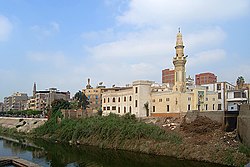Samannud
Samannud
سمنود Sebennytos | |
|---|---|
 Nile bank in Samannud | |
| Coordinates:30°58′00.0″N31°15′00.0″E/ 30.966667°N 31.250000°E | |
| Country | |
| Governorate | Gharbia |
| Area | |
| • Total | 57 sq mi (147 km2) |
| Population (2019 (estimated))[1] | |
| • Total | 410,388 |
| Time zone | UTC+2(EST) |
| ṯb-nṯr[2][3] inhieroglyphs | |||||||||
|---|---|---|---|---|---|---|---|---|---|
| Era:Late Period (664–332 BC) | |||||||||
Samannud(Arabic:سمنودSamannūd) is a city (markaz) located inGharbia Governorate,Egypt. Known inclassical antiquityasSebennytos(Greek:Σεβέννυτος), Samannud is a historic city that has been inhabited since theAncient Egyptianperiod. As of 2019, the population of themarkazof Samannud was estimated to be 410,388, with 83,417 people living in urban areas and 326,971 in rural areas.[1]
Etymology
[edit]The place known inEgyptian Arabic:سمنود[sæmænˈnuːd],was historically calledSebennytosorSebennytus.
- Coptic:ϫⲉⲙⲛⲟⲩϯ,andϫⲉⲃⲉⲛⲟⲩⲧⲉ,[4]Coptic pronunciation:[ʃæmˈnudi,ʃæβæˈnudæ]
- Late Coptic:ⲥⲉⲃⲉⲛⲛⲏⲧⲟⲩandⲥⲉⲃⲉⲛⲛⲉⲧⲟⲩ,[3][sæβænˈnidu,sæβænˈnædu]
- Ancient Greek:ΣεβέννυτοςandΣεβέννυς[5][3]orἡ Σεβεννυτικὴ πόλις[6]
- Egyptian:ṯb-(n)-nṯr)
The name Samannud ultimately derives from theAncient Egyptiannameṯb-(n)-nṯr,meaning "city of the sacred calf".[7]The name was probably pronounced */ˌcabˈnaːcar/in Old Egyptian and */ˌcəbˈnuːtə/or */ˌcəbənˈnuːtə/in Late Egyptian.[8]
Ancient history
[edit]Samannud (Sebennytos) was an ancient city ofLower Egypt,located on the now-silted up Sebennyticbranch of the Nile in the Delta.Sebennytos was thecapitalof Lower Egypt's twelfthnome—theSebennyte nome (district).Sebennytos was also the seat of theThirtieth Dynasty of Egypt(380–343 BCE).[9][10][11][12]
Sebennytos is perhaps best known as the hometown ofManetho,ahistorianandchroniclerfrom thePtolemaic era,c. 3rd century BC. Sebennytos was also the hometown ofNectanebo II;he was its last ruler.[13]
Atemplededicated to the local godAnhur,or Anhur-Shu,and his lioness goddess mateMehit,once existed at this location but is now reduced to ruins. A fragment from the location where kings would have made offerings to Anhur and his wife, is on display at theWalters Art Museum.[14]
Modern history
[edit]Samannud violently resisted theMuslim conquest of Egyptin 639, and remained rebellious for some time thereafter; the city revolted four times in the first half of the eighth century. ThreeCoptic Patriarchscame from Samannud:John III,Cosmas II,andJohn V.The 12th-centuryCopticphilologistYuhanna al-Samannudialso came from Samannud, and served as its bishop.[15]
| Year | Pop. | ±% |
|---|---|---|
| 1996 | 249,672 | — |
| 2006 | 298,166 | +19.4% |
| 2019 | 410,388 | +37.6% |
| Source: Citypopulation.de[1] | ||
Samannud's bishopric remained active through the late thirteenth century, indicating the presence of a large Christian population at the time.[16]
In 1843,John Gardner Wilkinsondescribed it as a place of some size, with the usualbazaarsof the large towns of Egypt, and famous for its pottery, which was sent to Cairo.[17]
The1885 Census of Egyptrecorded Samannud as a city in its own district inGharbia Governorate;at that time, the population of the city was 11,550 (5,686 men and 5,864 women).[18]
In religious traditions
[edit]In aCoptictradition, Sebennytos was part of the route of theHoly Familyduring theflight into Egyptnarrated in theGospel of Matthew(2:13–23).[19]
Gallery
[edit]-
Archeological findings from Sebennytos
-
Sidi Salama minaret
-
Church of the Holy Virgin and Apanoub
-
Mitwally minaret
-
Ghoneim Palace
-
Ibrahim Sirag el-Din Hammam
-
Qubba Darihiya
See also
[edit]References
[edit]- ^abcd"Samannūd (Markaz, Egypt)".Citypopulation.de.Retrieved20 June2020.
- ^Wallis Budge, E. A. (1920).An Egyptian hieroglyphic dictionary: with an index of English words, king list and geological list with indexes, list of hieroglyphic characters, coptic and semitic alphabets, etc. Vol II.John Murray.p.1059.
- ^abcGauthier, Henri (1929).Dictionnaire des Noms Géographiques Contenus dans les Textes Hiéroglyphiques Vol.6.p. 74.
- ^"أسماء بعض البلاد المصرية بالقبطية - كتاب لغتنا القبطية المصرية | St-Takla.org".st-takla.org.
- ^Ptolemyiv. 5. § 50,Stephanus of Byzantium
- ^Straboxvii. p. 802
- ^Sterling, Gregory E. (1992).Historiography and Self-Definition: Josephos, Luke-Acts, and Apologetic Historiography.Brill Publishers.p. 118.ISBN9004095012.Retrieved22 June2020.
- ^Loprieno, Antonio (1995)Ancient Egyptian: A Linguistic Introduction,Cambridge:Cambridge University Press,ISBN0-521-44384-9,p. 34
- ^Gray, Leon (2010).The New Cultural Atlas of Egypt.Marshall Cavendish.p. 143.ISBN9780761478775.
- ^Peck, Harry Thurston (1898).Harpers Dictionary of Classical Antiquities (1898).Harper and Brothers.
- ^Smith, William(1858).Dictionary of Greek and Roman Geography.Retrieved29 March2020.
- ^Cooper, William Ricketts (1876).An Archaic Dictionary: Biographical, Historical, and Mythological: From the Egyptian, Assyrian, and Etruscan Monuments and Papyri.S. Bagster and Sons.p. 496.
- ^Bill Manley, The Seventy Great Mysteries of Ancient Egypt "Thames & HudsonLtd, 2003. p.101
- ^Watterson, Barbara (2003).Gods of Ancient Egypt.History Press.p. 41.ISBN978-0-7524-9502-6.
- ^Sidarus, Adel (2017). "Yuhanna al-Samannudi, the Founder of National Coptic Philology in the Middle Ages". In Gabra, Gawdat; Takla, Hany N. (eds.).Christianity and Monasticism in Northern Egypt: Beni Suef, Giza, Cairo, and the Nile Delta.Oxford University Press.pp. 139–140.ISBN978-1617977800.Retrieved22 June2020.
- ^Tsuji, Asuka (2017). "The Veneration of Anba Hadid and the Nile Delta in the Thirteenth Century". In Gabra, Gawdat; Takla, Hany N. (eds.).Christianity and Monasticism in Northern Egypt: Beni Suef, Giza, Cairo, and the Nile Delta.Oxford University Press.p. 190.ISBN978-1617977800.Retrieved24 June2020.
- ^Wilkinson, John Gardner(1843).Modern Egypt and Thebes: Being a Description of Egypt, Including the Information Required for Travellers in that Country.John Murray.p. 432.
- ^Egypt min. of finance, census dept (1885).Recensement général de l'Égypte.p. 288.Retrieved21 June2020.
- ^"The Holy Family at Meniet Samanoud".Tour Egypt.Archivedfrom the original on 12 September 2016.Retrieved6 November2016.









